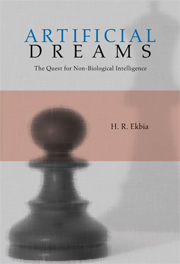Book contents
- Frontmatter
- Contents
- List of Figures and Tables
- Preface
- Prologue
- 1 GPS: The Origins of AI
- 2 Deep Blue: Supercomputing AI
- 3 Cyborgs: Cybernetic AI
- 4 Cyc: Knowledge-Intensive AI
- 5 Coach and Chef: Case-Based AI
- 6 Language Learning: Connectionist AI
- 7 Mathematical Models: Dynamical AI
- 8 Cog: Neorobotic AI
- 9 Copycat: Analogical AI
- Epilogue
- Appendix A Minimax and Alpha-Beta Pruning
- Appendix B An Introduction to Connectionism
- Appendix C The Language Acquisition Debate
- Notes
- Bibliography
- Author Index
- Subject Index
Appendix A - Minimax and Alpha-Beta Pruning
Published online by Cambridge University Press: 05 June 2012
- Frontmatter
- Contents
- List of Figures and Tables
- Preface
- Prologue
- 1 GPS: The Origins of AI
- 2 Deep Blue: Supercomputing AI
- 3 Cyborgs: Cybernetic AI
- 4 Cyc: Knowledge-Intensive AI
- 5 Coach and Chef: Case-Based AI
- 6 Language Learning: Connectionist AI
- 7 Mathematical Models: Dynamical AI
- 8 Cog: Neorobotic AI
- 9 Copycat: Analogical AI
- Epilogue
- Appendix A Minimax and Alpha-Beta Pruning
- Appendix B An Introduction to Connectionism
- Appendix C The Language Acquisition Debate
- Notes
- Bibliography
- Author Index
- Subject Index
Summary
THE MINIMAX ALGORITHM
In order for the evaluation process discussed in Chapter 2 to bottom out, the designer of a chess-playing machine chooses a certain look-ahead depth at which to stop the recursion. This depth depends on such factors as the speed and processing power of the hardware. In the case of Deep Blue, as was mentioned, the depth was fourteen. What this means is that, at each step, Deep Blue looks ahead fourteen plies (seven moves) into the game until it reaches a level in the tree where it should apply the scoring function to evaluate the nodes (leaves), and assign a number to each one. These numbers are then backed up to the top in order to choose the best move. Figure A.1(a) demonstrates how this is done in a two-ply game tree. (Notice that at every point in the middlegame, each player has more than thirty moves to choose from. Thus, each branching point in the tree actually splits into about thirty-five nodes, only a small number of which are shown in the figure, for the sake of simplicity.)
Assume that levels I and III in the tree represent the possible moves for the machine, and level II those for the opponent. Suppose also that the numbers on level III have been obtained by directly applying the scoring function to the board positions.
Information
- Type
- Chapter
- Information
- Artificial DreamsThe Quest for Non-Biological Intelligence, pp. 335 - 338Publisher: Cambridge University PressPrint publication year: 2008
